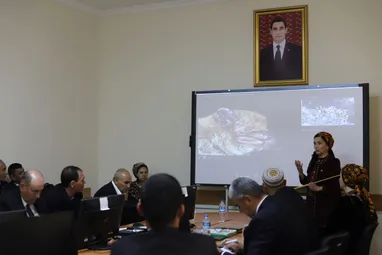WNAM REPORT: The traditional April summing up of environmental activities in Turkmenistan was held at the National Institute of Deserts, Flora and Fauna of the Ministry of Environmental Protection.
The results of scientific, practical and inspection work on the study and protection of nature for 2024 were presented by the heads of scientific departments from 9 state nature reserves of the country.
Shaniyaz Menliev from the Koytendag Nature Reserve confirmed the continuing increase in the number of markhor, a mountain markhor goat.
The report by Charyyar Tagiev (Syunt-Khasardag Nature Reserve) contained a message about looking after a single brown bear.
Aknabat Potaeva (Kopetdag Nature Reserve) reported on recent observations of cranes that feed for a short time during migration within the Myane-Chaacha Nature Reserve.
Akhmetzhan Sadykov (Amudarya Nature Reserve) spoke about his work at the zoo nursery, which houses the largest population of tugai deer in captivity in the country.
Nurymukhammed Khudaykulyev (Badkhyz Nature Reserve) reported the mass flowering of tulips, the satisfactory condition of the local leopard population, females of which are found with two, even three cubs (an adult pack presumably consists of 15 animals).
Bayram Tirkishev (Kaplankyr Reserve) shared information about pink flamingos visiting a chain of artificial reservoirs in the north of the country – Uzynshor, Zengi-baba, connected by collectors, Lake Sarykamysh, where during the migratory seasons the birds arrange a rest in secluded backwaters. Night work of “camera traps” indicated the presence of a small group of kulans.
The collection of information in a single collection is called “Chronicle of Nature”, published in limited copies for official use, contains a description of the state of rare flora and fauna, rare natural and weather phenomena, facts of discovery of new species for protected landscapes during the reporting year, results of expeditions, biotechnical, landscaping and fire prevention measures, work in nurseries, records, assessment of natural processes.
The publication reflects the current state of ecology, serves as a basis for planning, and is an actual document of the state’s activities in the field of preserving natural heritage, the source notes.


